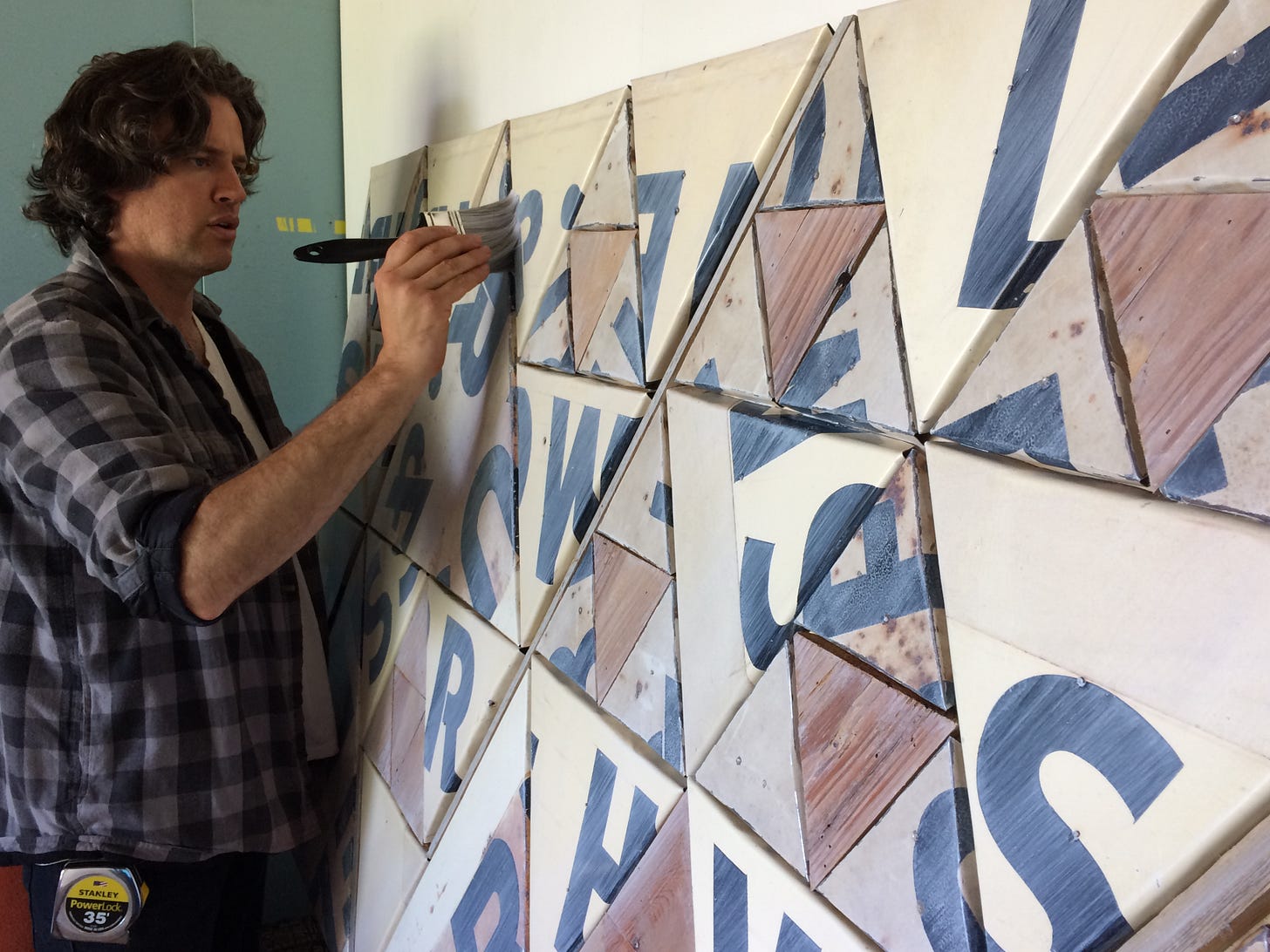How do we build a new reality while living in current reality where our safety and sanity is constantly under attack? That’s the thesis of my conversation with artist and Buckminster Fuller scholar, Benjamin Lowder.
Ben’s artist practice includes taking the old and transforming it into something new. Using found objects, with an emphasis on advertising (like the repurposed Orange Crush sign below), Ben metamorphosizes extractive materials by turning them into art that depicts the natural growth structures of the material universe—thereby breaking their spell.
I met Ben at the Philosophical Research Society during his showcase for the talk for his showcase Myth, Math & Magic Series: works constructed of reclaimed lumber and vintage metal signage. He gave a talk on Buckminster Fuller's Legacy & Manly P Hall's Wisdom in the context of Math, Myth, and Magic (you can watch it online here) and I was totally blown away.
Growing up in Vancouver (with architects in the family), I knew of Buckminster Fuller because of Science World, a geodesic dome built for World Expo 1986. My perception of him was as a revolutionary thinker and designer, but I had no idea just how brilliant he was—and with my own lack of understanding about sacred geometry, I wasn’t aware of his connections to alchemy and magic.
R. Buckminster Fuller (called Bucky by his family and friends) was an architect, systems theorist, writer, designer, inventor, philosopher, and futurist who set out to understand the coordinating system operative in universe. As Ben translates, Buckminster Fuller set out to understand the nature of God or, at least, how “sacred geometry can reveal the Creator’s hand in the material world.”
There appears to be a structure to our known world that can be understood, yes, through the wisdom traditions, but most prominently through the natural world’s expression of the phi (or golden) ratio. According to Bucky and Ben, if we build in accordance with this natural structure, we may one day be able to do everything with nothing.
“Don’t fight forces. Use them.”
- Buckminster Fuller
Setting out to build a home with reclaimed and recycled materials that by design would facilitate an environment free from migraines (with no petroleum based products creating fumes in the environment, lots of natural light and good thermal dynamics), Benjamin studied at how people built before the industrial revolution and found interest in ancient structures that had reoccurring proportions based off of phi ratios.
After building his home, Ben dove in Bucky’s work (he knew of his legacy from attending Southern Illinois University Carbondale where Fuller taught from 1959 to 1971) and gave up working in marketing to instead create art that repurposes advertising to express images aligned with the natural expression of the universe.
Today Ben serves on the board of the Fuller Dome Home, is the Creative Director at the Fuller Dome, is writing a book on Buckminster Fuller, and has his art on display at the bG Gallery in Santa Monica. He will be back at the Philosophical Research Society in April.
Check out Benjamin’s website, Fuller’s Dome Home, The Center for Spirituality and Sustainability Fuller Dome, and Cherokee Street Gallery. I hope you enjoy this conversation as much as I did!
Tune in now to visual artist and Buckminster Fuller scholar Benjamin Lowder talking about creating in alignment with the natural structures and patterns of the Universe, transmuting spells and word magic, how fear feeds the demiurge, the tension between fighting the old and building the new, and what it means to support Bucky's legacy.
As referenced in our talk—The Fuller Projection Map, also known as the “Dymaxion Map,” is the only flat map of the entire surface of the Earth which reveals our planet as one island in one ocean, without any visually obvious distortion of the relative shapes and sizes of the land areas, and without splitting any continents.
It was developed by R. Buckminster Fuller who “By 1954, after working on the map for several decades,” finally realized a “satisfactory deck plan of the six and one half sextillion tons Spaceship Earth.” - Buckminster Fuller Institute
“You do not belong to you. You belong to the universe. The significance of you will remain forever obscure to you, but you may assume you are fulfilling your significance if you apply yourself to converting all you experience to highest advantage to others. Make the world work, for 100% of humanity, in the shortest possible time, through spontaneous cooperation, without ecological offense or the disadvantage of anyone.”
- R. Buckminster Fuller





















Share this post